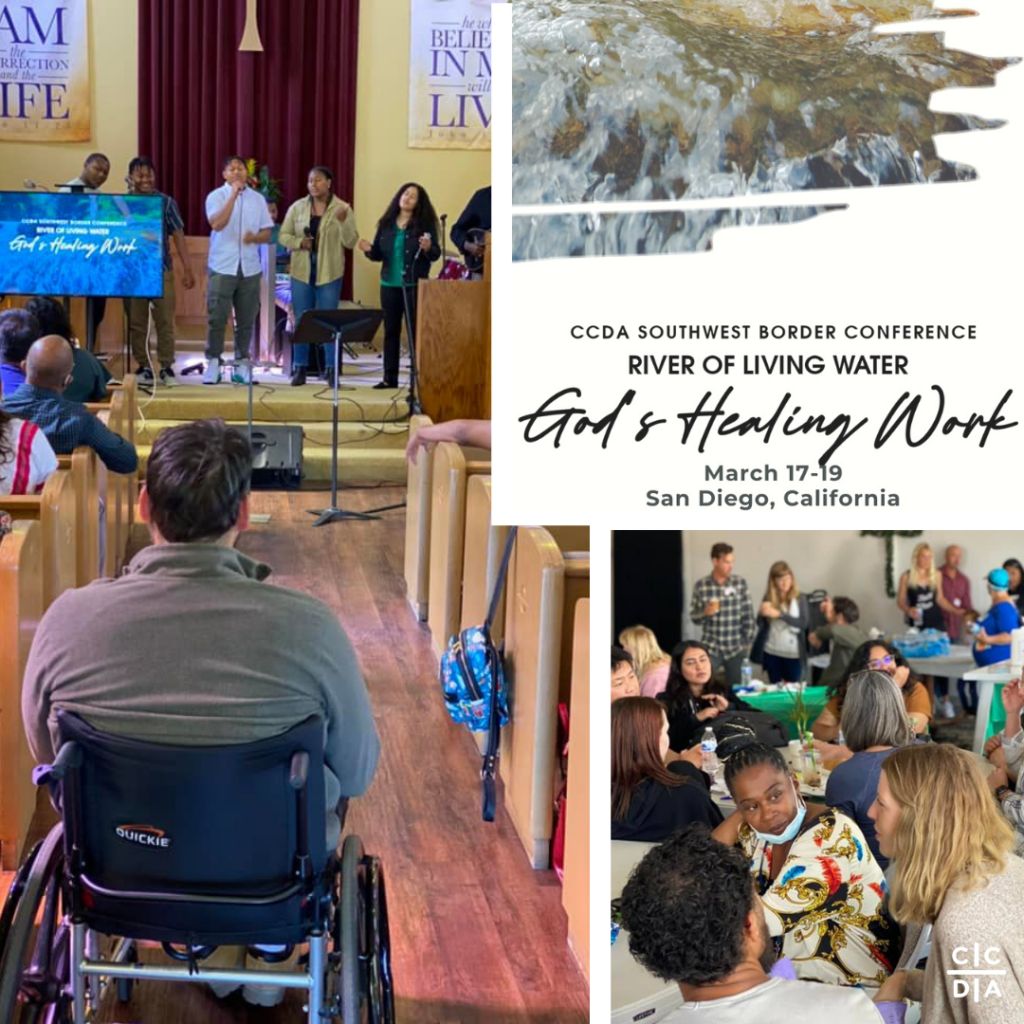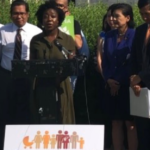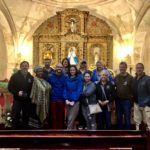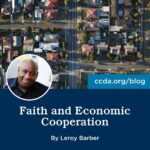
On Friday March 18, 2022, the CCDA Southwest Border Local Network, familia and community convened at the Tijuana-San Diego border to walk and talk through how God’s healing work has continually flowed even in the midst of a pandemic. The event’s theme was, Rivers of Living Water: God’s Healing Work or Rio de Agua Viva: La Obra Sanadora de Dios. To reflect on the event and get a glimpse into the gathering, I had the opportunity to interview two Puentes Collective co-founders, Berenice Soto and Vanessa Martinez Soltero. Both curated and led this year’s border pilgrimage along with Priscilla Merlo. While they contributed to the conference in additional ways such as leading in the conference planning committee, or with facilitating other workshops, this interview will focus on the border pilgrimage time.
Please Introduce yourself:
Vanessa: My pronouns are she/ella. I was born and raised in Mexico and migrated to the United States at the age of 12. I am a co-founder and board member of the Puentes Collective, which is an organization for Latine youth, Millennials, and Gen Z’ers at the intersection of faith and justice. We create spaces for people who have a calling to those two sectors of life in a way that honors all of who we are. I have also been doing immigration activism and policy work as an organizer for over 14 years. All of this work was started by my madrina Alexia Salvatierra, who is the one that mentored me into the work that I do today.
Berenice: I’m from San Diego, Kumeyaay land. Currently, I am co-program manager for the Sojourners Rising Leaders Fellowship, and I’m also a co-founder and board member of Puentes Collective. I have served students in College Ministry primarily in San Diego for over a decade, and was a part of the Lenses executive team, which was a platform for training faith leaders to live and minister across cultures. My hobbies include taking care of plants and working on my native garden.
Tell us about the border pilgrimage which you got to curate and lead.
Berenice: One of the goals for the conference was to center folks who have been marginalized and also folks who are having these lived experiences as part of the story. For these reasons, we decided to have Puentes lead the pilgrimage. As Puentes, part of our goal in the border pilgrimages, which we have been facilitating for over 3 years, is to ask who’s the hero of the story, to be decentering whiteness from that narrative, and let people be the heroes of their own stories. We try to do that throughout the process as we decide who gets to be the guides, which are often migrants or children of immigrants. When we get to Mexico, listening to their leaders, and getting to have conversations with some of the migrants, sets a space where people get to be the heroes of their own stories as part of the process.
Since the theme for the conference was of God’s healing work, the folks who are in these positions, and have stories of lived experiences, especially for the church we visited in Tijuana, have medicine to offer as they share about how they experience God’s healing work.
Vanessa: What I think is so beautiful in the pilgrimage process is coming back into the United States. Because we sometimes think of the border as a geopolitical border, it was important to learn the fluidity and statistics of what happens at the border. What does God have to say about it? What could be the church’s response? Especially in light of the fact that missions do not need to be across a border because there are people living in the United States under oppressive systems because of the lack of immigration reform. But also because we don’t know where we come from and under the pretense of assimilating, they are asking us to lose so much of our identity to be able to survive here. It has been very important for us to name and wrestle with some of those things, and allow the spirit of God to show us.
What was a challenge that you experienced during the session?
Berenice: Logistically, everything went smoothly to our surprise. We crossed back into the US in 30 minutes, y alcanzamos a comprar nieve (we even had time to stop for ice cream). The Tijuana church leadership of Iglesia Camino de Salvación, Alejandra and Abdiel, did a beautiful job at naming the challenges that are faced through migration statistics in two ways. First, statistics and consequences of those crossing the border into the United States, and second, the statistics and consequences of those crossing from the United states across the border and the consequences on Mexicans and Migrants which is not often talked about. They challenged us to question our intentions, and the messiness that comes with that, and not just be there for a quick fix. In this pilgrimage specifically, it was interesting to note that the attendees were black and indigenous people of color. It was really interesting that what I heard in people’s questions were statements like, “oh yeah, that happens to us in the US”, and so I wrestled with how to engage with that. Statistically speaking, immersions, or any sort of cultural immersion can often be more harmful in reinforcing stereotypes unless there’s intentional reflecting and debriefing happening. And so we put a lot of value in that.
Vanessa: The challenge for me is, how do we carry this grief without distracting ourselves from dealing with this grief and anger? How do we allow it to come in and to sit with it, without it overcoming all of our being? But also, what is the hope? At Chicano Park during the debrief, the challenge for many was with how and who are the voices being centered. So we invited all to reflect on who is getting the things together and preparing, leading, and organizing? Is it the people that are being directly impacted? If I am not that person, who do I know? Are we stopping to reflect on our motives? In wanting to do something good, it is easy to fall into this American hero mentality. How do we carry all of ourselves in, recognizing our blindspots, and having the humility to be called in by the people being affected directly, without taking offense to constructive feedback or criticism?
What is an unexpected space or place where you got to see God’s healing work?
Berenice: My mom Anita Soto came along to the border pilgrimage for the first time. We had done our own in the San Diego community in the past. But this time around I was interested in seeing her engage with the Tijuana portion of the pilgrimage, as she herself grew up in Tijuana and was a recipient of mission work. She contributed to the conversation in Tijuana, and it was beautiful to see my mom lead communion at the end of both the pilgrimage and the conference the next day. During the pilgrimage a quote that stuck to Vanessa was when she stated, “I may be a woman, I may not be a Pastor, but this still counts in the eyes of God” as she led it. Those were beautiful and powerful moments for me.
If there was a song to describe this moment in time for you, which song would it be?
Berenice: For me it is “Himno de Victoria” by Danny Berrios. It’s just a very beautiful and powerful song that’s about liberation, a collective liberation that takes a long time. Seeing the generational stuff going as I experienced this moment with my mom, Abdiel and Alejandra in Tijuana, and the CCDA team which were all representative of different generations was very much the vibe that connected me to this song.
Vanessa: “Puente a mi Gente” by Jose Puente y la Ola Fresca. Specifically a verse that says, si yo pudiera armar un puente de alma y de corazón, if I could build a bridge with heart and soul. There’s a lot of emotional work that goes into creating this structure and the intentionality of how we invite people in and who we learn from like when we were in Mexico. For me it points to bridges that are not transactional but relational, and it’s also a lively song!
“Let me tell you a story about water:
Once upon a time there was us.
America’s thirst tried to drink us away.
And here we still are.”
Natalie Diaz, “How the Milky Way Was Made: 11. Art of Fact“, Page 72
Postcolonial Love Poem
To learn more about the Latin American reality and Latin American and Latinx spirituality and theology, Berenice and Vanessa suggest the following readings:
[wa_restricted roles=”All” login_label=”Download the Resource List Here”]https://docs.google.com/document/d/1c2E6QrCsTQwipm-tXvEBTIa4GqZUUu5CwZmqGQXH0rw/edit?usp=sharing
[/wa_restricted]




